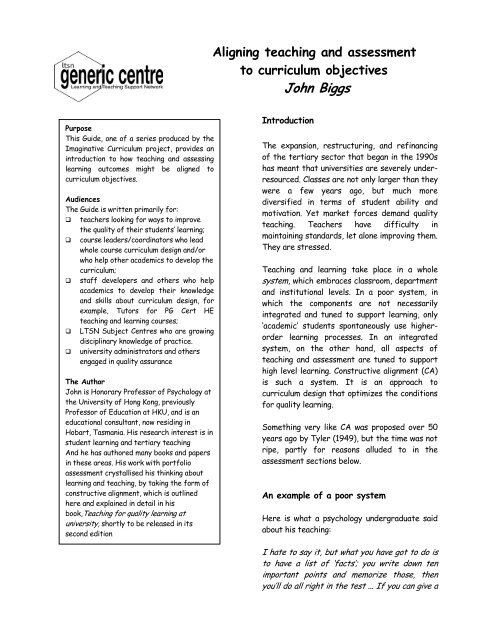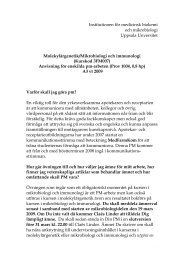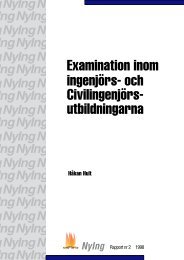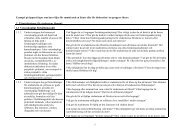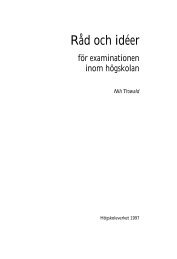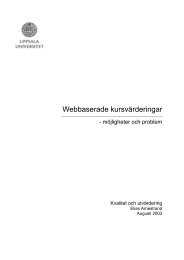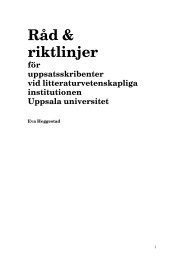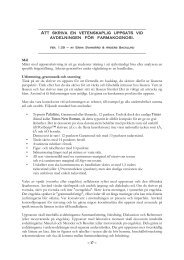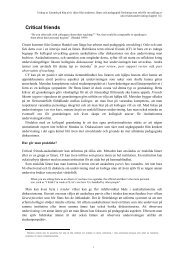Aligning teaching and assessment to curriculum objectives John Biggs
Aligning teaching and assessment to curriculum objectives John Biggs
Aligning teaching and assessment to curriculum objectives John Biggs
You also want an ePaper? Increase the reach of your titles
YUMPU automatically turns print PDFs into web optimized ePapers that Google loves.
<strong>Aligning</strong> <strong>teaching</strong> <strong>and</strong> <strong>assessment</strong><strong>to</strong> <strong>curriculum</strong> <strong>objectives</strong><strong>John</strong> <strong>Biggs</strong>PurposeThis Guide, one of a series produced by theImaginative Curriculum project, provides anintroduction <strong>to</strong> how <strong>teaching</strong> <strong>and</strong> assessinglearning outcomes might be aligned <strong>to</strong><strong>curriculum</strong> <strong>objectives</strong>.AudiencesThe Guide is written primarily for: teachers looking for ways <strong>to</strong> improvethe quality of their students’ learning; course leaders/coordina<strong>to</strong>rs who leadwhole course <strong>curriculum</strong> design <strong>and</strong>/orwho help other academics <strong>to</strong> develop the<strong>curriculum</strong>; staff developers <strong>and</strong> others who helpacademics <strong>to</strong> develop their knowledge<strong>and</strong> skills about <strong>curriculum</strong> design, forexample, Tu<strong>to</strong>rs for PG Cert HE<strong>teaching</strong> <strong>and</strong> learning courses; LTSN Subject Centres who are growingdisciplinary knowledge of practice. university administra<strong>to</strong>rs <strong>and</strong> othersengaged in quality assuranceThe Author<strong>John</strong> is Honorary Professor of Psychology atthe University of Hong Kong, previouslyProfessor of Education at HKU, <strong>and</strong> is aneducational consultant, now residing inHobart, Tasmania. His research interest is instudent learning <strong>and</strong> tertiary <strong>teaching</strong>And he has authored many books <strong>and</strong> papersin these areas. His work with portfolio<strong>assessment</strong> crystallised his thinking aboutlearning <strong>and</strong> <strong>teaching</strong>, by taking the form ofconstructive alignment, which is outlinedhere <strong>and</strong> explained in detail in hisbook,Teaching for quality learning atuniversity, shortly <strong>to</strong> be released in itssecond editionIntroductionThe expansion, restructuring, <strong>and</strong> refinancingof the tertiary sec<strong>to</strong>r that began in the 1990shas meant that universities are severely underresourced.Classes are not only larger than theywere a few years ago, but much morediversified in terms of student ability <strong>and</strong>motivation. Yet market forces dem<strong>and</strong> quality<strong>teaching</strong>. Teachers have difficulty inmaintaining st<strong>and</strong>ards, let alone improving them.They are stressed.Teaching <strong>and</strong> learning take place in a wholesystem, which embraces classroom, department<strong>and</strong> institutional levels. In a poor system, inwhich the components are not necessarilyintegrated <strong>and</strong> tuned <strong>to</strong> support learning, only‘academic’ students spontaneously use higherorderlearning processes. In an integratedsystem, on the other h<strong>and</strong>, all aspects of<strong>teaching</strong> <strong>and</strong> <strong>assessment</strong> are tuned <strong>to</strong> supporthigh level learning. Constructive alignment (CA)is such a system. It is an approach <strong>to</strong><strong>curriculum</strong> design that optimizes the conditionsfor quality learning.Something very like CA was proposed over 50years ago by Tyler (1949), but the time was notripe, partly for reasons alluded <strong>to</strong> in the<strong>assessment</strong> sections below.An example of a poor systemHere is what a psychology undergraduate saidabout his <strong>teaching</strong>:I hate <strong>to</strong> say it, but what you have got <strong>to</strong> do is<strong>to</strong> have a list of ‘facts’; you write down tenimportant points <strong>and</strong> memorize those, thenyou’ll do all right in the test ... If you can give a
it of factual information -- so <strong>and</strong> so did that,<strong>and</strong> concluded that -- for two sides of writing,then you’ll get a good mark. Quoted in Ramsden(1984: 144)If the teacher of this student thought that acritical evaluation of psychological theoriescould be h<strong>and</strong>led by selectively memorizing,there would be no problem. But surely theteacher didn’t think that. I hope not! As ithappened, this particular student graduatedwith First Class Honours. He liked writingextended essays, <strong>and</strong> held these quick <strong>and</strong>snappy <strong>assessment</strong>s in contempt. He made astrategic decision <strong>to</strong> memorise, knowing that itwas enough <strong>to</strong> get him through.The problem here? The <strong>assessment</strong> was notaligned <strong>to</strong> the aims of <strong>teaching</strong>. So often therhe<strong>to</strong>ric in courses <strong>and</strong> programmes is all thatit should be: students will graduate with a deepunderst<strong>and</strong>ing of the discipline, <strong>and</strong> the ability<strong>to</strong> solve problems creatively. Then they are <strong>to</strong>ldabout creative problem solving in packedlecture halls, <strong>and</strong> tested with multiple choicetests. It’s all out of kilter, but such a situationis not, I strongly suspect, all that uncommon.A good <strong>teaching</strong> environment is consistent.Teaching <strong>and</strong> <strong>assessment</strong> practices are aligned<strong>to</strong> the aims of <strong>teaching</strong>.So what does a goodsystem look like?Problem-based learning (PBL) is a very goodexample of aligned <strong>teaching</strong>. PBL is mostcommonly used in professional degreeprogrammes, such as architecture, medicine,<strong>and</strong> nursing, but it is also used on more‘academic’ programmes. The idea is thatgraduates should be able <strong>to</strong> performdifferently in the area of study on graduation,for example <strong>to</strong> solve professionally relatedproblems. In PBL, the main <strong>teaching</strong> method is<strong>to</strong> get the students <strong>to</strong> solve professionalproblems themselves (carefully selected as <strong>to</strong>difficulty <strong>and</strong> content), while the <strong>assessment</strong> isjudging how well they have solved them. Thereis alignment all the way through, from<strong>objectives</strong> through <strong>teaching</strong> method, <strong>to</strong><strong>assessment</strong>: all involve focusing on studentsdoing what they should be doing, solvingprofessional problems. Telling them the his<strong>to</strong>ryof architectural problem solving, or giving themmultiple choice tests on the knowledge needed<strong>to</strong> solve problems, or learning the principles ofproblem solving, might be interesting <strong>and</strong>useful, but they are not the central issue. Thecentral issue is putting knowledge <strong>to</strong> work.PBL is an excellent example of an alignedsystem, probably the purest example, but mostapproaches <strong>to</strong> <strong>teaching</strong> can be aligned moreeffectively than they are already.What is constructive alignment?CA has two aspects. The ‘constructive’ aspectrefers <strong>to</strong> what the learner does, which is <strong>to</strong>construct meaning through relevant learningactivities. The ‘alignment’ aspect refers <strong>to</strong> whatthe teacher does, which is <strong>to</strong> set up a learningenvironment that supports the learningactivities appropriate <strong>to</strong> achieving the desiredlearning outcomes. The key is that thecomponents in the <strong>teaching</strong> system, especiallythe <strong>teaching</strong> methods used <strong>and</strong> the <strong>assessment</strong>tasks, are aligned <strong>to</strong> the learning activitiesassumed in the intended outcomes. The learneris in a sense ‘trapped’, <strong>and</strong> finds it difficult <strong>to</strong>escape without learning what is intended shouldbe learned.In this Guide, let us focus on aligning asemester length unit or course. There are fourmajor steps.1. Defining the intended outcomes (the<strong>objectives</strong>)2. Choosing <strong>teaching</strong>/learning activitieslikely <strong>to</strong> lead <strong>to</strong> attaining the <strong>objectives</strong>
3. Assessing students’ learning outcomes<strong>to</strong> see how well they match what wasintended4. Arriving at a final gradeDefining the <strong>objectives</strong>:the intended outcomesWhen we teach:a. we must have a clear idea of what wewant our students <strong>to</strong> learn.b. on a <strong>to</strong>pic by <strong>to</strong>pic basis, we must havea further idea as <strong>to</strong> how well we wanteach <strong>to</strong>pic <strong>to</strong> be unders<strong>to</strong>od.As <strong>to</strong> (a), we should distinguish betweendeclarative knowledge <strong>and</strong> functioningknowledge.Declarative knowledge is knowledge that we can‘declare’: tell somebody, read about. Librariesare full of the stuff. It is the basis ofacademic disciplines. But it is usually only thefirst part of the s<strong>to</strong>ry. We don’t acquireknowledge only so that we can tell other peopleabout; more importantly, we need <strong>to</strong> putknowledge <strong>to</strong> work, <strong>to</strong> make it function. Toreally underst<strong>and</strong> something, you see the worlddifferently, <strong>and</strong> behave differently <strong>to</strong>wardsthat part of the world. This is obviously thecase in professional faculties; we want lawyers<strong>to</strong> make good legal decisions, doc<strong>to</strong>rs <strong>to</strong> makeaccurate diagnoses. But we also want physicists<strong>to</strong> think <strong>and</strong> behave like physicists. Aftergraduation, all our students, whatever theirdegree program, should see a section of theirworld differently, <strong>and</strong> <strong>to</strong> behave differently,expertly <strong>and</strong> wisely. Thus, if these are our<strong>objectives</strong>, then simply telling our studentsabout that part of the world, getting them <strong>to</strong>read about it, <strong>and</strong> then getting them <strong>to</strong> tell allthat back <strong>to</strong> you – in their own words, ofcourse! – is not likely <strong>to</strong> achieve our intendedoutcomes. Not for the majority of students.The good ones, the ‘academic’ ones, willthemselves turn declarative in<strong>to</strong> functioningknowledge in time, but most will not if they arenot required <strong>to</strong>.We have <strong>to</strong> require them <strong>to</strong>. We have <strong>to</strong> stateour <strong>objectives</strong> in terms of what we wantstudents <strong>to</strong> do. We should require them <strong>to</strong>perform their underst<strong>and</strong>ing, not just tell usabout it.As <strong>to</strong> (b), our <strong>curriculum</strong> is usually listed in<strong>to</strong>pics <strong>to</strong> be covered. Once you’ve <strong>to</strong>ld themabout it, that’s it: <strong>to</strong>pic covered. But some<strong>to</strong>pics are more important than others, theyrequire a deeper level of underst<strong>and</strong>ing.Students only need <strong>to</strong> know about some <strong>to</strong>pics –they know where <strong>to</strong> go <strong>to</strong> look it up in future ifthey have <strong>to</strong> – while other <strong>to</strong>pics must beunders<strong>to</strong>od at a level that allows them <strong>to</strong> putthat <strong>to</strong>pic <strong>to</strong> work, perhaps in a new contextthey haven’t experienced before. So, again,those <strong>to</strong>pics need <strong>to</strong> be stated in terms of whatthe students are required <strong>to</strong> do, not what youthe teacher have <strong>to</strong> ‘cover’ in class, or set asrequired reading.Overall <strong>objectives</strong>, <strong>and</strong> <strong>to</strong>pic <strong>objectives</strong>, arethus about what the student has <strong>to</strong> do. Thinkverbs.Following are four levels of underst<strong>and</strong>ing, withsome illustrative verbs for each level. Ofcourse, each discipline will have its own verbs aswell, <strong>and</strong> remember that each verb has a <strong>to</strong>picobject. The following is a general framework,based on the SOLO Taxonomy (<strong>Biggs</strong>, 2003).Minimal underst<strong>and</strong>ing, sufficient <strong>to</strong> deal withterminology, basic facts: Memorize, identify,recognizeDescriptive underst<strong>and</strong>ing, knowing aboutseveral <strong>to</strong>pics: Classify, describe, list.Integrative underst<strong>and</strong>ing, relating facts<strong>to</strong>gether <strong>and</strong> underst<strong>and</strong>ing basic theory: apply<strong>to</strong> known contexts, integrate, analyse, explainthe aetiology.
Extended underst<strong>and</strong>ing, being able <strong>to</strong> gobeyond what has been taught, deal creativelywith new situations: Apply <strong>to</strong> novel contexts,hypothesize, reflect, generate.The first step in designing the <strong>curriculum</strong><strong>objectives</strong>, then, is <strong>to</strong> make clear what levels ofunderst<strong>and</strong>ing we want from our students inwhat <strong>to</strong>pics.Once we have done that, we need <strong>to</strong> decide howwe are going <strong>to</strong> get them <strong>to</strong> do it. Those verbs,<strong>and</strong> others that suit your own discipline,become the markers throughout the system.They need <strong>to</strong> be embedded in the<strong>teaching</strong>/learning activities, <strong>and</strong> in the<strong>assessment</strong> tasks. They keep us on track.Choosing <strong>teaching</strong>/learningactivities (TLAs)We usually take TLAs for granted. The defaultTLAs in many courses are lecture <strong>and</strong> tu<strong>to</strong>rial:lecture <strong>to</strong> expound <strong>and</strong> package, <strong>and</strong> tu<strong>to</strong>rial <strong>to</strong>clarify <strong>and</strong> extend. However, the verbs thesecontexts elicit are not necessarily high level ifthe student is not so inclined. Students can getaway with being passive, whereas high levellearning requires them <strong>to</strong> be active in theirlearning.There are many options for creatingappropriate learning contexts (Chapter 5, <strong>Biggs</strong>2003) but even the large class allows a widerange of relevant student activity – if only thelecturer s<strong>to</strong>ps talking now <strong>and</strong> then, <strong>and</strong>requires students <strong>to</strong> question each other aboutjust taught content, <strong>to</strong> reflect, <strong>to</strong> swap notes,<strong>to</strong> do exercises, <strong>to</strong> self-test, <strong>and</strong> so on (seeChapter 6, op. cit.). Then of course there is arange of activities that can be scheduledoutside the classroom, especially but not onlyusing IT (Chapter 10, op cit.). In fact, problemsof resourcing conventional on campus <strong>teaching</strong>,<strong>and</strong> the changing nature of HE, are coming <strong>to</strong>be blessings in disguise, forcing learning <strong>to</strong> takeplace outside the class, with group <strong>and</strong> peer<strong>teaching</strong>, independent learning <strong>and</strong> work-basedlearning, all of which are a rich source ofrelevant learning activities.Assessing students’ learning outcomesIt is no exaggeration <strong>to</strong> say that faultyassumptions <strong>and</strong> practices about <strong>assessment</strong> domore damage than any other single fac<strong>to</strong>r. AsRamsden (1992) puts it, the <strong>assessment</strong> is the<strong>curriculum</strong>, as far as the students areconcerned. They’ll learn what they think they’llbe assessed on, not what’s in the <strong>curriculum</strong>, orwhat’s been ‘covered’ in class.The trick is, then, <strong>to</strong> make sure the <strong>assessment</strong>tasks mirror what you intended them <strong>to</strong> learn.That pre-empts the sort of cynical gameplayingwe saw in our psychology undergraduate,above, with his ‘two pages of writing’.But there’s a much broader problem, whichmust be addressed full-on. The fact is, themost common <strong>assessment</strong> practices make suchalignment all but impossible.Two approaches <strong>to</strong> <strong>assessment</strong>Two approaches <strong>to</strong> <strong>assessment</strong> underlie currenteducational practice. The first is thetraditional model. We teach, then we test.Next, we order students along a quantitativescale, usually a percentage scale, which is doneby the familiar process of ‘marking’, <strong>and</strong> thenwe allocate grades. Grading can be carried outby stipulating arbitrary cut-off points: 75+becomes an A, 65 – 74, B, <strong>and</strong> so on. A commonalternative is <strong>to</strong> grade on the curve or <strong>to</strong> normreference.That is, the <strong>to</strong>p 15 per cent, say, areawarded A; the next 25 per cent B, <strong>and</strong> so on.In either method of grading, the commonfeature is that the students’ performanceshave <strong>to</strong> be quantified. Quantification isachieved in one or both of two ways. First,knowledge is broken down in<strong>to</strong> units that areclassified as correct or incorrect, <strong>and</strong> thecorrect units are added or averaged. Second, a
performance, such as an essay or a problemsolution, is reduced <strong>to</strong> independent components(such as content, style, originality, etc.), whichare then rated on separate rating scales, themaxima of which are frequently chosen <strong>to</strong> addup <strong>to</strong> 100. The final performance is thenassessed as the sum of the separate ratings. Itis then assumed that we have a clear,‘objective’ scale along which we can comparestudents’ performances.The second approach <strong>to</strong> <strong>assessment</strong> iscriterion-referenced. That is, the score anindividual obtains reflects how well theindividual meets preset criteria, those beingthe <strong>objectives</strong> of <strong>teaching</strong>. This is what I amtalking about here: alignment between<strong>objectives</strong> <strong>and</strong> <strong>assessment</strong>. But before I dealwith this, let me outline some of the problemswith the traditional model.What’s wrong with the traditionalapproach <strong>to</strong> <strong>assessment</strong>?Underlying the quantitative approach <strong>to</strong><strong>assessment</strong> is what Taylor (1994) calls the‘measurement model’, which derives fromindividual differences psychology. Psychologistswere concerned about how individuals differedfrom each other on fixed traits. They createdsophisticated test procedures, which relied onseveral assumptions. For example, traits arenormally distributed, <strong>and</strong> so therefore testscores should be <strong>to</strong>o. Thus, an ability test isconstructed on the assumption that very feware really bright, most fall in the middle <strong>and</strong> afew really dull, in the familiar bell shape.Unfortunately, the educational fraternitypounced on psychometric-type tests, wateredthem down, <strong>and</strong> used them inappropriately inthe classroom.There are many problems with this approach.Underlying them all is that there is no essentialalignment between what outcomes are intended,what is taught, <strong>and</strong> what is assessed. Any quick<strong>and</strong> dirty test with a modicum of face validity(‘two pages of writing’, for instance) can beused <strong>to</strong> produce an ordering of students.Here are only some of the particular problems:1. Expressing performances as percentages isassumed <strong>to</strong> create a universal currencythat is equivalent across subjects areas,<strong>and</strong> across students. This assumption iscompletely unsustainable. How can 50% inEnglish be equivalent <strong>to</strong> 50% in His<strong>to</strong>ry?How then can scores on these differentscales be averaged? Think about it.2. A high average in most components of acourse covers failure in other components.The reasoning here – that the studentclearly had the ability <strong>to</strong> pass, so an overallpass is justified – is also unsustainable. Thelogic of awarding a pass <strong>to</strong> a student on asection of the course in which that studenthas already failed is difficult <strong>to</strong> grasp.3. Tests should be unidimensional, <strong>and</strong> have ahigh test-retest reliability. Complexperformances are however notunidimensional, <strong>and</strong> <strong>teaching</strong> is supposed <strong>to</strong>produce change in what is being measured,a change usually called ‘learning’. Measuringchange, using a model that assumes thatwhat is being measured is stable, seemssomewhat peculiar.4. The effects of quantitative <strong>assessment</strong>s onstudent learning (‘backwash’) negative.Quantifying sends the wrong messages <strong>to</strong>students. For example: Ideas are equally important Individual trees are more importantthan the wood You can skip or slack on certain areas ifyou are doing well elsewhere Written tests make declarativeknowledge more important thanapplication Verbatim responses must gain somecredit Grading on the curve makes success<strong>and</strong> failure depend on uncontrollablefac<strong>to</strong>rs such as relative ability <strong>and</strong> luck
As there is no intrinsic connectionbetween the <strong>curriculum</strong> <strong>and</strong><strong>assessment</strong>, just focus on what will getyou through the <strong>assessment</strong>.For a further treatment of this controversial<strong>to</strong>pic see <strong>Biggs</strong> (2003, Chapters 8, 9).So what’s the alternative?The alternative is an <strong>assessment</strong> system thattells you how well each individual student’sassessed performances match what is required.Surely this is the aim of all <strong>teaching</strong>. Itrequires teachers <strong>to</strong> state desired outcomes inthe form of st<strong>and</strong>ards or criteria thatstudents are <strong>to</strong> attain. How well they attainthem, minimally or beyond reasonableexpectations, is reflected in the gradingsystem. Most students should be able <strong>to</strong> reachthem at an ‘acceptable’ level.Matching individual performances against thecriteria is not a matter of counting marks bu<strong>to</strong>f making holistic judgments. And this is whereteachers start <strong>to</strong> worry. Judgment is‘subjective’, isn’t it?, while quantitative markingis precise <strong>and</strong> objective. In case of dispute youcan point <strong>to</strong> a number, a score: You didn’t getenough marks, sorry. Isn’t that much easierthan justifying a holistic judgment?No. Those ‘marks’ are themselves anaccumulation of mini-subjective judgments. Theresidual error is probably greater than that inan holistic judgment that can be justified byargument <strong>and</strong> reference <strong>to</strong> the criteria.Rather, I would ask you <strong>to</strong> justify why 75 <strong>and</strong>over should be an A. Why not 70? Or 90? It isalmost universally accepted that getting halfright, 50 per cent, should be a pass. Why?Numbers, <strong>and</strong> arbitrary cutting points, onlyappear <strong>to</strong> make the process objective <strong>and</strong>precise. It is not at all.So we come back <strong>to</strong> holistic judgment.Teachers should be able <strong>to</strong> justify theirjudgments. And this is so much easier if thecriteria <strong>to</strong> be met are spelled out in the initial<strong>objectives</strong>. Dealing with student disputes thenbecomes a seminar on the nature of goodlearning, not a demeaning quibble over a markhere, a mark there.An example: Arriving at a final gradeLet us look at an example of qualitative grading.The following were the grading criteria I usedin a unit in a Master’s programme foreducational psychologists.CURRICULUM AND INSTRUCTIONCourse Objectives <strong>and</strong> Grade CriteriaGrading will be based on your attaining the following<strong>objectives</strong>:1. demonstrate that you correctly underst<strong>and</strong> <strong>and</strong>can apply the principles of good <strong>teaching</strong> <strong>and</strong><strong>assessment</strong> <strong>to</strong> chosen contexts.2. demonstrate a knowledge of selected aspects of<strong>curriculum</strong> design <strong>and</strong> management <strong>and</strong> how theyrelate <strong>to</strong> the educational system in Hong Kong.3. show how the content <strong>and</strong> experiences in thiscourse may enhance your effectiveness as an EP.4. show evidence of reflective decision-makingFinal grades will depend on how well you c<strong>and</strong>emonstrate that you have met all <strong>objectives</strong>:A: awarded if you have clearly met all the<strong>objectives</strong>, displaying deep knowledge of thebase content, original <strong>and</strong> creative thinking,perhaps going beyond established practice.B: awarded when all <strong>objectives</strong> have been met verywell <strong>and</strong> effectively.C: awarded when the <strong>objectives</strong> have beenaddressed satisfac<strong>to</strong>rily, or where the evidenceis strong for some <strong>objectives</strong>, weaker butacceptable in others.F: less than C, work plagiarised or not submitted.
The students were given the above, <strong>and</strong> thefinal <strong>assessment</strong> was based on a portfolio theysubmitted comprising: a paper, a report, arationale of a group presentation, <strong>and</strong> a selfevaluationin which they made their case as <strong>to</strong>how they thought they had addressed each ofthe <strong>objectives</strong>. On an <strong>assessment</strong> sheet h<strong>and</strong>edback <strong>to</strong> the students, each item was discussedin terms of what <strong>objectives</strong> it met <strong>and</strong> how well.The grade was immediately apparent. Nocounting, no arbitrary, unsustainable decisions.It <strong>to</strong>ok a little longer than marking a finalexam, but not much longer.There’s a postscript. The university requiredreporting in percentages, otherwise thecomputer system could not calculate finalgrades. So I simply used the existing arbitrarypercentage cut-offs, but after the event. Thatis, my qualitatively allocated grades determinedthe percentage reported, not vice versa: apercentage did not determine the grade. Thebackwash <strong>to</strong> students was thereforequalitative, not quantitative; they knew whatthey had <strong>to</strong> do <strong>to</strong> get an A,. On the other h<strong>and</strong>,knowing that they had <strong>to</strong> accrue 70 marks <strong>to</strong>get an A is not very helpful, except they had <strong>to</strong>scrabble for marks wherever they could. So, inmy case, if 70+ was an A, <strong>and</strong> I had judged theportfolio <strong>to</strong> meet the requirements for A, thenif it was a bare A, I awarded 72 of these markthings; if it was a good A, I gave 78, <strong>and</strong> so on.The final irony was that final grades werereported in? Yes, A, B, C, <strong>and</strong> F categories! So Igraded in categories, converted in<strong>to</strong> marks, only<strong>to</strong> be converted back in<strong>to</strong> categories again.Just why teachers were not required <strong>to</strong> reportin categories in the first place is one of thoseeternal mysteries of university administration.The effect on most staff was, unfortunately,<strong>to</strong> mark in percentages from the start, with allthe attendant problems mentioned above.So we can get around many bureaucraticobstacles <strong>to</strong> aligned <strong>teaching</strong> <strong>and</strong> <strong>assessment</strong>.The important thing in an aligned qualitativeapproach is that the criteria for differentiallyacceptable levels of performance are there forall <strong>to</strong> see, <strong>and</strong> the determination of a student’sperformance is completely transparent, ascriterion-referenced <strong>assessment</strong>s are, orshould be. Norm-referenced <strong>assessment</strong>scannot be transparent in the nature of thecase, because it depends on how clever theother students are as much as on how cleveryou the student are.Some might perceive a difficulty at this point.What if most of my students, say eighteen ou<strong>to</strong>f a class of twenty, met the criteria for A?Wouldn’t I be seen as a soft <strong>to</strong>uch? Wouldn’<strong>to</strong>thers look at the results <strong>and</strong> say: Thest<strong>and</strong>ard is obviously <strong>to</strong>o low? Well, yes, I’msure many would say that. The important thingis how I derived those criteria for an A. If Iderived them by judging, perhaps inconsultation with the profession, that agraduating psychologist needed <strong>to</strong> meet certaincriteria, <strong>and</strong> they were those I’d adopted for agrade of A, then it’s party time, surely.Congratulations all round.What is more likely is that the Board ofExaminers would throw up their arms <strong>and</strong>dem<strong>and</strong> a regrade: No more than fifteenpercent should be A’s, twenty at absolute most!Otherwise, whatever will they think of us!This is measurement model thinking. Becauseability is distributed along the normal curve,the majority of the class must, by a law ofnature, be awarded middle grades, a few <strong>to</strong>pgrades, a few low passes or fail. That argumentassumes that ability determines learningoutcomes, not that good learning is facilitatedby good <strong>teaching</strong>. My definition of good<strong>teaching</strong>, on the other h<strong>and</strong>, is where westarted. If we can provide an environment inwhich unpromising students display the qualityof work that only good students had displayedhither<strong>to</strong>, that’s good <strong>teaching</strong>. Good <strong>teaching</strong>beats the distribution of ability, it does notfollow it.
Anyway, the student intake is certainly notnormally distributed with respect <strong>to</strong> ability.Even these days, we’re still only accepting lessthan half the upper ability end of the agerange.In short, there is absolutely no justification oneducational grounds for prescribing fixedproportions of grade categories. Such a policy,which is not uncommon, is adopted for cosmeticreasons: it’s good PR <strong>to</strong> show even gradedistributions across department, across years.But it cuts right across any attempt <strong>to</strong> set upaligned <strong>teaching</strong>, <strong>and</strong> must therefore beresisted.Another example:The learning portfolioWhen I first used portfolio <strong>assessment</strong> inanother unit in an undergraduate programme,the backwash <strong>to</strong>ok over, <strong>and</strong> in effect dictatedthe TLAs (<strong>and</strong> in fact what led me <strong>to</strong> CA). Inthis case, alignment was created bot<strong>to</strong>m up.The unit in question was a compulsorysemester-long unit in the third year of a fouryear part-time evening Bachelor of Educationprogramme at the University of Hong Kong. Thestudents were primary <strong>and</strong> secondary teachersin Government schools. The general aim of theunit was not <strong>to</strong> teach students aboutpsychology (they already had completed a firstyear unit in educational psychology), but <strong>to</strong> getthem <strong>to</strong> demonstrate that they could drivetheir classroom decision-making with theirpsychological knowledge, based on reflectivepractice. Such an aim would be appropriate <strong>to</strong>advanced units in most professionalprogrammes.Once the <strong>to</strong>pics were decided, it was necessary<strong>to</strong> define the levels of underst<strong>and</strong>ing that were<strong>to</strong> be attained. This was done in terms of theverbs indicating the level of underst<strong>and</strong>ingrequired for each letter-grade:A. Reflect on their own <strong>teaching</strong>, evaluatetheir classroom decisions in terms oftheory, <strong>and</strong> thereby improve their<strong>teaching</strong>, formulate a theory of <strong>teaching</strong>that demonstrably drives decisionmaking<strong>and</strong> practice, generate newapproaches <strong>to</strong> <strong>teaching</strong> on that basis.B. Apply course content, recognize good <strong>and</strong>poor applications of principles. ‘Missed A’,that is, had a good try at reflecting butdidn’t quite make it.C. Underst<strong>and</strong> declarative; discuss contentmeaningfully, know about content <strong>to</strong>pics.Also include ‘missed B’.D. Underst<strong>and</strong> in a minimally acceptableway: essentially ‘missed C’, or ‘badlymissed B’.E. ‘Missed D’; plagiarised; didn’t participatesatisfac<strong>to</strong>rily; didn’t h<strong>and</strong> in work.If students could unequivocally demonstrate inthe items chosen for their portfolios the levelof performance indicated by the verbs in thecategory, that category grade would beawarded, given that the other performancetasks were all satisfac<strong>to</strong>ry. Thus, formulatingthe actual <strong>objectives</strong> was not at allcomplicated, <strong>and</strong> the ensuing <strong>assessment</strong>procedures were also straightforward.In the first class of the semester, I circulatedthe above <strong>objectives</strong> <strong>and</strong> discussed them,making sure the students knew the st<strong>and</strong>ardsthey would have <strong>to</strong> meet. They were <strong>to</strong>ld thatthey had <strong>to</strong> convince me that their learning inthe unit met the <strong>objectives</strong>. They were <strong>to</strong>decide on the evidence for their learning in theform of items for their portfolio, <strong>and</strong> <strong>to</strong>explain where they thought the portfolio as awhole met the <strong>objectives</strong>. Specifically, therequirements were:1. Four pieces of evidence selected by thestudent2. A reflective journal, including answers <strong>to</strong>the main idea questions for each plenarysession.
3. A justification for selecting the items, <strong>and</strong>the overall case they were supposed <strong>to</strong>make as a learning package. This providedvery good evidence of students’metacognitive awareness of their learning.A list of possible item types suggested itemswas provided by request, but original itemtypes were encouraged.The portfolio was a completely new task <strong>to</strong>them, <strong>to</strong> which most initially reacted verynegatively. They dem<strong>and</strong>ed guidelines, examplesof possible items, <strong>and</strong> complained bitterlyabout the perceived workload. In the event, Ihave <strong>to</strong> admit that their initial complaintsabout the workload were justified. Four items,apart the journal <strong>and</strong> the justifications, were<strong>to</strong>o many. Three would have been better.The following dialogue, condensed from severalsessions, illustrates how this happened (S arestudents, T is teacher):S: What sort of items do we select?T: That’s up <strong>to</strong> you. Think hard about the<strong>objectives</strong>. Here’s a list of sample items youmight include. (I take a few <strong>and</strong> explain howthey might work).S: Can we have a trial run?T: Yes, <strong>and</strong> if you’re happy with my <strong>assessment</strong>of it you can submit it as an item.S: How do we show we can reflect?T: Use your journal.S: What do we put in it?T: What you think are critical incidents in your<strong>teaching</strong>. Talk it over with your colleagues.Form a learning partnership.Sit next <strong>to</strong> your partner in class, get theirphone number or email. You can help eachother.S: Wouldn’t it be better if we had discussiongroups of students <strong>teaching</strong> the samesubjects as we do? Then we can shareexperiences on similar problems.T: Certainly. You can form groups in the roomnext door.S: We need direct <strong>teaching</strong> on the <strong>to</strong>pics. Willyou lecture us?T: Only if I really need <strong>to</strong>. There’s a <strong>to</strong>pic foreach session. The pre-reading should do,just a few pages, before each session. I’llthen meet half the class at a time, whilethe other having are in discussion groups.We can clarify each <strong>to</strong>pic in the lecture, asnecessary. And so on.In short, the <strong>assessment</strong> task drove thestudents’ learning activities, which had <strong>to</strong>address the <strong>objectives</strong>, <strong>and</strong> the TLAs evolvedaround that.The students’ experienceStudent reactions gave an interesting insightin<strong>to</strong> the way alignment worked. One studentreferred <strong>to</strong> the portfolio as ‘a learning <strong>to</strong>ol’.In fact, it is difficult <strong>to</strong> separate what is aTLA <strong>and</strong> what an <strong>assessment</strong> task in an alignedsystem. Students learn what they aresupposed <strong>to</strong> learn, <strong>and</strong> they are graded on howwell they learn it. What could be simpler?The negotiated <strong>teaching</strong> activities stimulatedthe students <strong>to</strong> respond in the way required,as the following quotations from theirportfolios indicate::What (we are expected) <strong>to</strong> prepare forthe portfolio undoubtedly provide me achance <strong>to</strong> reflect on my daily <strong>teaching</strong>.This would never happen if this moduleproceeds in the same way as the othermodules. I would not be so alert about myown <strong>teaching</strong> <strong>and</strong> eager <strong>to</strong> make changes<strong>and</strong> improvements.Instead of bombing us with lengthylectures <strong>and</strong> lecture notes, we have <strong>to</strong>reflect on our own learning experiences<strong>and</strong> <strong>to</strong> respond critically ...I feel quiteexcited as this course is gradually leadingme <strong>to</strong> do something positive <strong>to</strong> my<strong>teaching</strong> career <strong>and</strong> <strong>to</strong> experience realgrowth.
Student reactionsinitially negative:<strong>to</strong> the portfolio wereHow about the <strong>assessment</strong>? Aiyaa!ANXIETY! ANXIETY! ANXIETY! I was sopuzzled <strong>and</strong> worried about it when Ireceived the h<strong>and</strong>out on the first meeting.And a backh<strong>and</strong>er <strong>to</strong> me:This (the portfolio) is going <strong>to</strong> be anightmare! At least, if it had been anessay, I would have known what isexpected of me ...Have I ever caused thesame kind of fear among my students? Imust bear in mind <strong>to</strong> be more reasonable<strong>and</strong> careful when giving my studentsassignments from now on ... only give themassignments that are well designed <strong>and</strong>really necessary <strong>to</strong> help them in theirlearning ... make sure they underst<strong>and</strong>what is expected of them ... make suresufficient time is given for completing ....By the end of the unit, however, reactions weremore positive:You will be willing <strong>to</strong> do more than whatthe lecturers want you <strong>to</strong> do. Thecircumstance is like a little kid who haslearnt something new in school <strong>and</strong> can'twait <strong>to</strong> tell his/her parents.I learn more from the portfolio than in thelesson.All (the teacher) said was ‘show me theevidence of your learning that has takenplace’ <strong>and</strong> we have <strong>to</strong> ponder, reflect <strong>and</strong>project the theories we have learnt in<strong>to</strong>our own <strong>teaching</strong> …How brilliant! If it hadonly been an exam or an essay, we wouldhave probably just repeated his ideas <strong>to</strong>him <strong>and</strong> continued <strong>to</strong> teach the same wayas we always do!Another example of alignment in an engineeringprogram is given by Hough<strong>to</strong>n (2002), which isdesigned specifically <strong>to</strong> fit within existing QAAprocedures.Conceptions of <strong>teaching</strong>,of the <strong>curriculum</strong>It is now well accepted that teachers teachaccording <strong>to</strong> their beliefs about the nature of<strong>teaching</strong> <strong>and</strong> of what the <strong>curriculum</strong> is about.Some see the <strong>curriculum</strong> as being entirelyconcerned with content the students have <strong>to</strong>take on board, the ‘transfer’ conception:knowledge being transferred from theteacher’s head <strong>to</strong> the students’ heads (I wouldrather see this as ‘reduplication’, otherwise theteacher is left a babbling ignoramus after eachlecture). Others see the <strong>curriculum</strong> as process,as the experience the students have, whichincludes the values that are transferred in theso-called ‘hidden’ <strong>curriculum</strong>. Where does CAst<strong>and</strong> on these issues?Actually, I think CA is neutral on most. It is ameta-principle of <strong>curriculum</strong> design, which canincorporate a variety of particular conceptions.The only aspect it cannot incorporate is, as Isay, norm-referencing. But you can criterionreference anything. For example, say I am avery stern traditionalist. Here are the <strong>to</strong>pics <strong>to</strong>be covered, <strong>and</strong> they have <strong>to</strong> be learned exactlyright, verbatim. Very well, the <strong>objectives</strong> areclear, the TLA is exposition, the <strong>assessment</strong> isbased on verbatim recall. It does not tap theupper reaches of constructive learning(memorisation is a narrow-b<strong>and</strong> constructiveactivity), but it is one, <strong>and</strong> the design is alignedthroughout.CA does emphasise process, however. The verbsare really ways of requiring students <strong>to</strong> think inrequired ways, not just <strong>to</strong> achieve outcomes.But again, the processes are built in<strong>to</strong> the<strong>objectives</strong> <strong>and</strong> they can be high level or lowlevel.
The value of CA in addressing the hidden<strong>curriculum</strong> came out beautifully in many of thestudent comments, some of which are quotedabove. All were teachers, <strong>and</strong> the experience ofbeing required <strong>to</strong> reflect on their own learning,enabled them <strong>to</strong> reassess their <strong>teaching</strong>, as isseen in the following:When I am a learner, I expect theteachers <strong>to</strong> provide me with good learning.When I am a teacher, I just neglect thelearners. Is this fair?As Ronald, one of my classmates, said,‘They are practising what they preach’. Hiswords recall my memory of Michael Fullan’spremise in his book Change Forces:‘Faculties of education should not beadvocating things for teachers or schoolsthat they are not capable of practisingthemselves.Constructive alignment is precisely that:practising what you preach. The medium is themessage.Advantages of aligned <strong>teaching</strong>The advantages of <strong>teaching</strong> <strong>and</strong> assessing inthis way have been emphasised already. In sum:It’s more rewarding as a teacher, <strong>and</strong> moreenriching. We are forced <strong>to</strong> reflect on whatwe mean by ‘underst<strong>and</strong>ing’, <strong>and</strong> how we canfoster it.The students see that what they arelearning is real. They’re being required <strong>to</strong>show that they can operate moreeffectively with what they have learned,not just talk about it. Cynicism, that enemyof deep learning, is much less likely.The outcomes on graduation translate in<strong>to</strong>informed action, which is what thecommunity expects. Although the approach is common sense, itrequires a different way of thinking about<strong>teaching</strong>, <strong>and</strong> in particular about defininglevels of underst<strong>and</strong>ing. It requires a theory of <strong>teaching</strong> yourdiscipline over <strong>and</strong> above knowledge of thediscipline itself; <strong>and</strong> knowledge abou<strong>to</strong>ptions for <strong>teaching</strong> <strong>and</strong> <strong>assessment</strong>. Thisis where LTSN centres <strong>and</strong> staffdevelopers can be vital resources <strong>and</strong>supports. Time. Academics are more stressed thanever, <strong>and</strong> in the initial stages setting up analigned system requires thought, <strong>and</strong> theredesign <strong>curriculum</strong>, <strong>teaching</strong> methods, <strong>and</strong><strong>assessment</strong>s. Institutional requirements, such asquantitative reporting, <strong>and</strong> grading on acurve, make aligned <strong>teaching</strong> difficult.It looks like the negatives outweigh thepositives, but that’s only if you thinkquantitatively.Why not try it for yourself.References <strong>and</strong> Further Reading<strong>Biggs</strong>, J.B. (2003). Teaching for quality learningat university. Buckingham: The OpenUniversity Press.Hough<strong>to</strong>n, W. (2002) Using QAA subjectbenchmark information: an academicteachers perspective.Ramsden, P. (1984). The context of learning. InF. Mar<strong>to</strong>n, D. Hounsell, <strong>and</strong> N. Entwistle, N.(eds), The Experience of Learning.Edinburgh: Scottish Academic Press.Ramsden, P. (1992). Learning <strong>to</strong> teach in highereducation. London: Routledge.Taylor, C. (1994). Assessment for measuremen<strong>to</strong>r st<strong>and</strong>ards: The peril <strong>and</strong> promise oflarge scale <strong>assessment</strong> reform. AmericanEducational Research Journal, 31, 231-262.Disadvantages <strong>and</strong> impediments
Tyler, R.W. (1949). Basic principles of<strong>curriculum</strong> <strong>and</strong> instruction. Chicago:University of Chicago PressSeptember 2003


